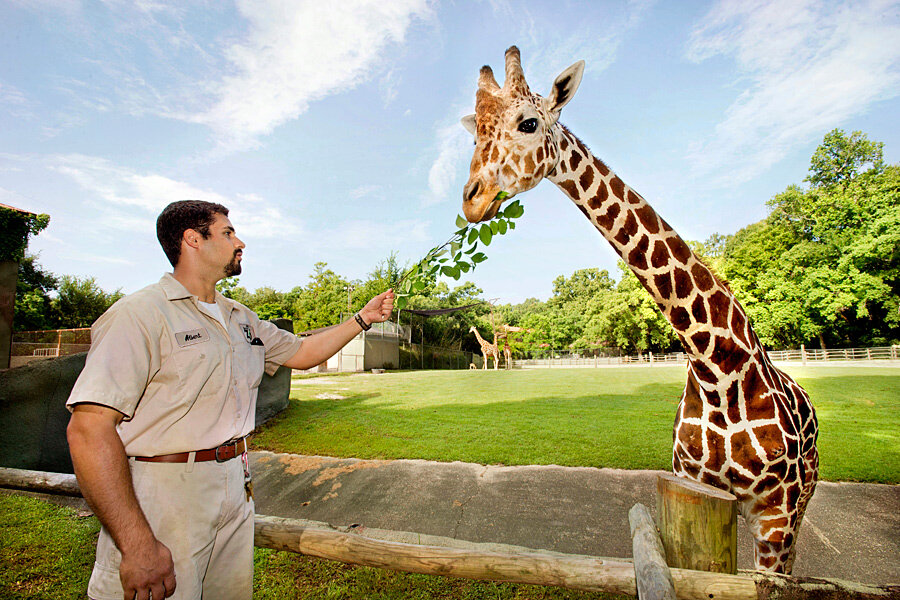Giraffe killing produces more outrage. But can legal hunting help?
Loading...
Adding to the recent furor over trophy hunting in Africa, an accountant in Idaho has come under fire from animal rights activists over photos she posted online with a giraffe and other wildlife she hunted on the continent.
Sabrina Corgatelli took the pictures during a legal guided hunt in South Africa. Besides the giraffe, the photos show her posing with an impala, a warthog, and a wildebeest. The public outrage over trophy hunting erupted with the illegal killing of Cecil, a favorite lion in Zimbabwe, by a Minnesota dentist last month.
“Everybody thinks we’re coldhearted killers, and it’s not that,” Ms. Corgatelli said in an interview on NBC’s "Today" show. “There is a connection to the animal, and just because we hunt them doesn’t mean we don’t have a respect for them."
The photos posted by Corgatelli originally surfaced on a Facebook page that details a variety of her hunting expeditions and expressed support for Walter Palmer, the hunter who has admitted to shooting Cecil.
“Giraffes are very dangerous animals,” she added in her interview on "Today." “They could hurt you seriously, very quickly.”
While there have been limited instances of giraffes trampling people to death, many zoos across the United States allow hand-feeding of giraffes by adults and young children. Giraffes, with their cute pointy ears and generally docile nature, have been seized on by anti-hunting activists as symbols of their cause.
Corgatelli isn’t the first woman to receive public shaming for hunting a giraffe. Rebecca Francis, of Wyoming, posted a photo of herself with a dead giraffe – a photo that British comedian Ricky Gervais found and tweeted out to his 8 million followers, leading to death threats and harassment.
Since the photos of Corgatelli went viral, her Facebook page has been flooded with comments criticizing her and her hunting activity. The photos also got a response from Mr. Gervais.
“What's really sad nowadays is that these big game trophy hunters see fame as an added bonus to their perversion. Just like serial killers,” he tweeted Monday.
But some experts say that legal hunting expeditions, like the kind that Corgatelli went on, could actually be beneficial for wildlife conservation.
They point to Kenya, which banned trophy hunting in 1977. Catherine Semcer of the anti-poaching organization Humanitarian Operations Protecting Elephants told New York Magazine that the country “has lost between 60 and 80 percent of their large mammals outside of parks” as a result.
Corgatelli's hunting companion, Aaron Neilson, says that legal hunting is actually supportive of wildlife and their conservation because fees from big-game hunters go to protecting animals and national parks from poaches and habitat loss.
“It’s not about the few lions that are killed every year by sports hunters. It’s about the tens of thousands of acres of habitat that are lost every year,” Mr. Neilson told "Nightline." “Hunting absolutely is the only tool right now that’s paying for the vast majority of the wildlife conservation throughout the continent of Africa.... We might take a small surplus of [lions], but without what we’re doing, there won’t be any of them at all.”
In 2006, researchers from Kenya’s Mpala Research Centre interviewed 150 people who hunt or plan to hunt in Africa and found that 86 percent said they prefer hunting in an area where they know that a portion of the proceeds go back to local communities.
Jason Goldman wrote about the results in Conservation Magazine and argued for a reframing of the debate, away from massive outrage over individual hunting incidents.
“It’s encouraging that trophy hunters seem willing to take conservation-related issues into consideration when choosing a tour operator, but it is possible that they were simply providing the researchers with the answers that would cast them in the best light,” he wrote. “But ... perhaps the message that the species needs saving has a larger problem to address than the relatively limited loss of animals to wealthy hunters.”








